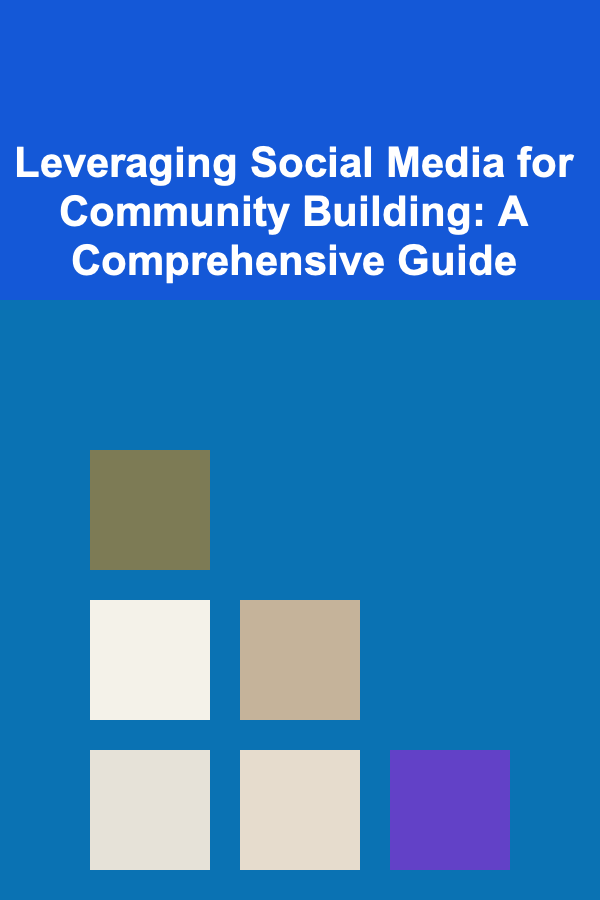
Leveraging Social Media for Community Building: A Comprehensive Guide
ebook include PDF & Audio bundle (Micro Guide)
$12.99$9.99
Limited Time Offer! Order within the next:

In today's digital age, social media has become an indispensable tool for communication, networking, and, crucially, community building. It transcends geographical boundaries, connecting individuals with shared interests, values, or goals in unprecedented ways. However, simply having a presence on various platforms is not enough. Effective community building requires a strategic and nuanced approach, focusing on genuine engagement, fostering meaningful interactions, and providing real value to members. This article delves deep into the strategies and best practices for leveraging social media to cultivate thriving communities.
Understanding the Fundamentals of Online Communities
Before diving into tactics, it's essential to understand what constitutes a successful online community. It's more than just a group of people following a brand or subscribing to a page. A true community possesses several key characteristics:
- Shared Purpose or Identity: Members are united by a common interest, goal, passion, or identity. This could be anything from a love of a specific product or service to a shared profession, a common cause, or a geographical location.
- Meaningful Interaction: The community provides a space for members to connect, share ideas, ask questions, and offer support to one another. This involves active participation and a sense of belonging.
- Reciprocity and Collaboration: Members contribute to the community and benefit from the contributions of others. There's a sense of give and take, fostering a culture of collaboration and mutual respect.
- Sense of Belonging and Identity: Members feel connected to the community and identify with it. This fosters loyalty and encourages continued participation.
- Moderation and Governance: Clear guidelines, moderation, and leadership are crucial for maintaining a positive and productive environment.
Without these elements, a social media presence risks being merely a broadcast channel rather than a genuine community.
Choosing the Right Platforms: Aligning with Your Target Audience
Not all social media platforms are created equal, and the best platform for building your community will depend heavily on your target audience and the nature of your community. Here's a brief overview of some popular platforms and their strengths:
- Facebook: Facebook's vast reach makes it a powerful tool for connecting with a broad audience. Facebook Groups are particularly effective for building communities around specific interests, topics, or brands. Features like events, polls, and live video make it easy to engage members.
- Instagram: Primarily visual, Instagram is ideal for communities centered around aesthetics, lifestyle, or creativity. Its emphasis on images and videos makes it perfect for brands with strong visual content. Instagram Stories and Reels offer opportunities for behind-the-scenes glimpses and interactive content.
- Twitter: Twitter's real-time nature makes it suitable for communities interested in news, current events, or quick updates. Hashtags are crucial for organizing conversations and attracting new members. It's excellent for building thought leadership and engaging in public discussions.
- LinkedIn: A professional networking platform, LinkedIn is ideal for building communities around industries, professions, or career development. LinkedIn Groups provide a space for professionals to connect, share knowledge, and network.
- YouTube: The premier video-sharing platform, YouTube is perfect for communities that thrive on visual content. Creating tutorials, vlogs, or live streams can build a loyal following and foster engagement.
- TikTok: A short-form video platform popular with younger audiences, TikTok is ideal for communities centered around entertainment, trends, or challenges. Its algorithm can lead to rapid growth and virality.
- Discord: A dedicated platform for online communities, Discord offers a wide range of features, including text and voice channels, role-based permissions, and bots for automation. It's particularly popular with gamers and online communities that require a high degree of customization.
- Reddit: A platform composed of diverse communities called subreddits, Reddit allows users to discuss virtually any topic imaginable. Engaging authentically and providing value within relevant subreddits can establish credibility and attract new community members.
Key Considerations When Choosing a Platform:
- Target Audience Demographics: Where does your target audience spend their time online? Research which platforms they frequent and tailor your efforts accordingly.
- Content Format: Does your content lend itself more to visual, textual, or video-based formats? Choose a platform that aligns with your content strengths.
- Community Features: Does the platform offer the features you need to build a thriving community, such as groups, forums, live streaming, or moderation tools?
- Platform Algorithm: Understand how the platform's algorithm works and optimize your content for maximum reach and engagement.
It's often beneficial to focus your efforts on one or two platforms where you can make a significant impact, rather than spreading yourself too thin across multiple platforms.
Developing a Community Strategy: Setting Goals and Defining Your Approach
A well-defined community strategy is essential for success. This involves setting clear goals, defining your target audience, and outlining your approach to engagement and content creation.
Setting Community Goals:
What do you hope to achieve by building a community? Common goals include:
- Brand Awareness: Increase visibility and recognition of your brand.
- Customer Loyalty: Strengthen relationships with existing customers and foster loyalty.
- Customer Support: Provide a platform for customers to ask questions and receive support from other users or your team.
- Lead Generation: Attract new leads and generate sales through community engagement.
- Product Feedback: Gather valuable feedback from users to improve your products or services.
- Thought Leadership: Establish yourself as an expert in your field and build credibility.
- Advocacy: Turn community members into brand advocates who promote your brand to others.
Your goals should be specific, measurable, achievable, relevant, and time-bound (SMART). For example, instead of "increase brand awareness," a SMART goal might be "increase followers on Instagram by 20% in the next three months."
Defining Your Target Audience:
Who are you trying to reach with your community? Create detailed personas that represent your ideal community members. Consider their demographics, interests, needs, and pain points. This will help you tailor your content and engagement strategies to resonate with them.
Outlining Your Approach to Engagement and Content Creation:
How will you engage with your community members and what type of content will you create? Consider the following:
- Content Calendar: Plan your content in advance to ensure consistency and variety. Include a mix of informative, entertaining, and interactive content.
- Engagement Strategies: How will you encourage members to participate? This could include asking questions, running contests, hosting live Q&A sessions, or creating challenges.
- Moderation Guidelines: Establish clear rules of conduct and moderation policies to ensure a positive and respectful environment.
- Community Voice: Define the overall tone and communication style for your community. This helps establish a consistent brand identity.
Creating Engaging Content: Providing Value and Sparking Conversation
Content is the lifeblood of any online community. To attract and retain members, you need to create content that is valuable, engaging, and relevant to their interests. Here are some content ideas to consider:
- Informative Content: Share helpful tips, tutorials, how-to guides, and industry news. Position yourself as a valuable resource for your community members.
- Entertaining Content: Share funny memes, relatable stories, and engaging videos. Humor can be a powerful way to connect with your audience.
- Interactive Content: Ask questions, run polls, create quizzes, and host contests. Encourage members to participate and share their opinions.
- Behind-the-Scenes Content: Give your community members a glimpse into your company culture, product development process, or daily operations. This can help build trust and transparency.
- User-Generated Content (UGC): Encourage members to create and share their own content related to your brand or community. This can be a powerful way to build engagement and authenticity. Feature UGC prominently to reward participation.
- Live Video: Host live Q&A sessions, interviews, or product demos. Live video allows you to connect with your community in real-time and answer their questions.
- Case Studies: Showcase successful applications or use cases related to your product, service, or community focus. These demonstrate the tangible benefits of participation.
Key Considerations for Content Creation:
- Relevance: Ensure your content is relevant to the interests and needs of your target audience.
- Value: Provide value to your community members by offering helpful information, entertainment, or solutions to their problems.
- Authenticity: Be genuine and transparent in your communication. People are more likely to connect with brands and individuals they perceive as authentic.
- Consistency: Post regularly to keep your community engaged and active.
- Variety: Mix up your content formats to keep things interesting.
- Visual Appeal: Use high-quality images and videos to capture attention and enhance engagement.
Don't be afraid to experiment with different content formats and strategies to see what works best for your community. Analyze your analytics to track your progress and adjust your approach as needed.
Fostering Engagement: Building Relationships and Encouraging Participation
Creating great content is only half the battle. You also need to actively foster engagement and build relationships with your community members. Here are some strategies to consider:
- Respond to Comments and Messages Promptly: Show your community members that you value their input by responding to their comments and messages in a timely manner.
- Ask Questions and Encourage Discussion: Pose open-ended questions to spark conversations and encourage members to share their thoughts and opinions.
- Run Polls and Quizzes: Engage members with interactive polls and quizzes to gather feedback and learn more about their preferences.
- Host Contests and Giveaways: Incentivize participation by running contests and giveaways. Offer prizes that are relevant to your community.
- Recognize and Celebrate Community Members: Highlight outstanding contributions from community members by featuring them on your page or website. This can help build loyalty and encourage others to participate.
- Create a Sense of Exclusivity: Offer exclusive content, discounts, or early access to products or services to reward community members.
- Facilitate Peer-to-Peer Interaction: Encourage members to connect with each other and share their experiences. This can help build a stronger sense of community.
- Establish Community Guidelines: Create a clear set of rules for behavior and communication to ensure a respectful and positive environment. Enforce these guidelines consistently.
- Active Moderation: Regularly monitor community activity and address any issues promptly. This includes removing spam, addressing inappropriate behavior, and answering questions.
- Welcome New Members: Make new members feel welcome by offering a personalized greeting and introducing them to the community.
Remember to be genuine and authentic in your interactions. People can tell when you're being insincere, and it can damage your credibility.
Measuring Success: Tracking Key Metrics and Analyzing Results
It's important to track your progress and measure the success of your community building efforts. This will help you identify what's working and what's not, and make adjustments to your strategy as needed. Key metrics to track include:
- Engagement Rate: The percentage of your audience that is actively engaging with your content (e.g., liking, commenting, sharing).
- Reach: The number of unique users who have seen your content.
- Website Traffic: The amount of traffic that is driven to your website from your social media channels.
- Lead Generation: The number of leads that are generated through your social media efforts.
- Customer Satisfaction: How satisfied your customers are with your brand or community. This can be measured through surveys or customer feedback.
- Community Growth Rate: The rate at which your community is expanding in terms of members.
- Sentiment Analysis: The overall tone and emotion expressed in community discussions. Monitoring sentiment helps identify potential issues and gauge overall community satisfaction.
Use social media analytics tools to track these metrics and analyze your results. Most social media platforms offer built-in analytics tools, but there are also a number of third-party tools available.
Analyzing Your Results:
- Identify Trends: Look for patterns in your data to identify what types of content and engagement strategies are most effective.
- Compare Results: Compare your results to your goals and benchmarks to see how you're performing.
- Adjust Your Strategy: Make adjustments to your strategy based on your findings. If something isn't working, don't be afraid to try something new.
Regularly monitor and analyze your results to ensure that you're on track to achieve your community building goals. This iterative process allows you to refine your approach and maximize your impact.
Advanced Strategies: Going Beyond the Basics
Once you've mastered the fundamentals of community building, you can explore some advanced strategies to take your community to the next level:
- Influencer Marketing: Partner with influencers in your niche to reach a wider audience and build credibility. Ensure that influencers align with your brand values and target audience.
- Community Advocacy Programs: Create formal programs to reward and recognize your most active and loyal community members. This could include exclusive access, discounts, or opportunities to contribute to your brand.
- Offline Events: Host in-person events to connect with your community members face-to-face. This can help build stronger relationships and foster a deeper sense of belonging.
- Gamification: Introduce game mechanics, such as points, badges, and leaderboards, to incentivize participation and engagement.
- Personalized Experiences: Tailor the community experience to individual members based on their interests and preferences. This could include personalized content recommendations or targeted offers.
- Integrate with Other Platforms: Connect your social media community with your website, email list, and other online channels to create a seamless user experience.
- Develop a Knowledge Base: Create a central repository of helpful information and resources for your community members. This can help reduce support requests and empower members to find answers to their questions.
- Create Sub-Communities: Segment your community into smaller, more focused sub-communities based on specific interests or topics. This can help improve engagement and relevance.
- Run Contests and Giveaways Collaboratively: Partner with other brands or influencers to run joint contests and giveaways. This can help you reach a wider audience and generate buzz.
These advanced strategies can help you create a truly thriving and engaged community that provides significant value to your members and your brand.
Common Mistakes to Avoid
Building a successful online community is challenging, and it's easy to make mistakes along the way. Here are some common pitfalls to avoid:
- Ignoring Your Community: Failing to respond to comments, questions, or messages can make your community members feel ignored and unvalued.
- Being Too Promotional: Constantly pushing your products or services can turn off your audience and make your community feel like a sales pitch.
- Failing to Moderate: Not moderating your community can lead to spam, harassment, and a negative environment.
- Lack of Consistency: Inconsistent posting or engagement can lead to a decline in participation and interest.
- Ignoring Negative Feedback: Ignoring negative feedback can damage your credibility and alienate your community members. Address concerns openly and honestly.
- Not Having a Clear Purpose: Without a defined purpose or shared identity, your community will lack direction and cohesion.
- Trying to Be Everywhere at Once: Spreading yourself too thin across multiple platforms can lead to a lack of focus and reduced effectiveness.
- Buying Followers or Engagement: Purchasing fake followers or engagement is unethical and can damage your credibility.
- Failing to Adapt: Social media is constantly evolving. Failing to adapt to new trends and technologies can leave your community behind.
By avoiding these common mistakes, you can increase your chances of building a thriving and engaged online community.
Conclusion
Leveraging social media for community building is a powerful strategy for businesses and organizations of all sizes. By understanding the fundamentals of online communities, choosing the right platforms, developing a community strategy, creating engaging content, fostering engagement, and measuring success, you can cultivate thriving communities that drive brand awareness, customer loyalty, lead generation, and advocacy. Remember to be genuine, authentic, and consistent in your efforts, and always prioritize the needs and interests of your community members. With a strategic and dedicated approach, you can harness the power of social media to build vibrant and impactful online communities.
Reading More From Our Other Websites
- [Mindful Eating Tip 101] Best Mindful Eating Strategies for Reducing Food Waste in Small Households
- [Skydiving Tip 101] How Much Does a First Skydiving Jump Really Cost?
- [Scrapbooking Tip 101] DIY Paper Swaps: Transforming Plain Scrapbooking Sheets into Unique Designs
- [Organization Tip 101] How to Organize Your Kids' Toys by Age and Interest
- [Home Budget 101] How to Track Your Home Budget Progress and Make Adjustments
- [Survival Kit 101] Best Survival Kit for Overlanders Exploring Remote African Safaris
- [Home Budget Decorating 101] How to Create a Gallery Wall on a Shoestring Budget: Tips and Tricks
- [Personal Care Tips 101] How to Make Your Own Natural Facial Scrub at Home
- [Organization Tip 101] How to Organize Your Home Security Devices Effectively
- [Digital Decluttering Tip 101] The Minimalist's Guide to a Clean Phone: Apps, Photos, and Notifications

How to Advertise Your Yard Sale to Attract More Customers
Read More
How to Maintain Your Home's Siding and Prevent Premature Wear
Read More
How to Make a Checklist for Making Your Website Mobile-Accessible
Read More
How to Store Seasonal Toys Effectively
Read More
How To Plan Your Garden Layout for Success
Read More
How to Become a Versatile Graphic Designer
Read MoreOther Products

How to Advertise Your Yard Sale to Attract More Customers
Read More
How to Maintain Your Home's Siding and Prevent Premature Wear
Read More
How to Make a Checklist for Making Your Website Mobile-Accessible
Read More
How to Store Seasonal Toys Effectively
Read More
How To Plan Your Garden Layout for Success
Read More